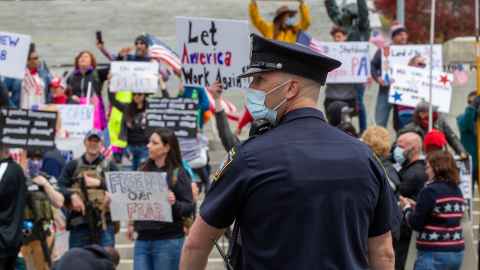What’s driving the lockdown protests over Covid-19?
28 April 2020
Opinion: Protests over Covid-19 lockdowns have erupted around the world, but what's causing them? Robert Bartholomew explores what history tells us about epidemics and civil unrest.

Protests over Covid-19 lockdowns have erupted around the world. In Italy, workers have taken to the streets to pressure politicians to open factories. In Germany, Thomas Prudlo took part in a "freedom rally" after being arrested for breaking quarantine by sitting alone on a park bench. In Brazil, President Jair Bolsonaro joined protesters at a rally to lift lockdowns ordered by state governors.
Unrest has broken out in numerous U.S. states from California to Florida as President Trump has urged protesters to "liberate" their states from quarantine. In Pennsylvania, protestors chanting "Government tyranny" and "Let me work" gathered at the capitol in Harrisburg. Michigan protestors gathered outside the home of the governor to denounce what some called "draconian laws." In New Hampshire, several hundred demonstrators waved placards reading "Live Free or Die"—the state motto. One of the largest protests was in Washington State where an estimated 2,500 protests gathered in Olympia.
An Associated Press poll shows little support for the protests within mainstream American society. It found that nearly 80 percent of U.S. citizens are in favour of their local lockdown measures. Just 12 percent said the measures where they live had gone too far, while 26 percent indicated they had not gone far enough. However, opinion polls are snapshots in time, and public sentiments can shift.
Quarantines have been used throughout history to control disease outbreaks. They often generate controversy and public backlash because they highlight two opposing elements of society: civil liberties versus the public good.
There are many examples of quarantines spawning protest movements, often to the surprise of authorities. These protests are typically accompanied by rumours and conspiracy theories, which thrive in situations of uncertainty and anxiety, especially when they relate to health. The presence of misinformation and disputes among elites may further contribute to the unrest. This is exactly what we are seeing with the presentation of alternative views downplaying the severity of the pandemic on influential conservative media outlets such as Fox News, suggesting that many states can reopen faster than what most mainstream health officials contend.
Two well-known psychological processes can further drive these divisions. The first is "motivated perception": the tendency for people to see what they want to see. It can be considered a form of wish-fulfillment. Another process is "confirmation bias," the tendency to seek out and pay more attention to views that support our pre-existing beliefs while downplaying dissenting perspectives.
The staggered, uneven manner in which the state governors are planning to reopen, while others remain in strict lockdown, is likely to further foment frustration in those who adhere to the "it’s OK to lift the lockdown" narrative. Images of people bathing on the beaches of Florida and getting haircuts in Georgia, and the perceived injustice and inequality in the way states slowly reopen is a recipe for greater, not less, social unrest. Common historical factors fostering unrest following government-imposed restrictions during quarantines are social and economic inequalities that are exacerbated by the appearance of the disease. Pre-Covid-19 disparities in American society include unequal access to healthcare, concern over corporate wealth and the gap between rich and poor, privacy issues, and the perceived erosion of civil liberties.
Since the 19th century, many riots have followed the response to government restrictions imposed during cholera outbreaks. Amidst the Great Cholera Pandemic of 1832, rumours spread through the streets of Paris that the sickness was a deliberate attempt by the rich and powerful to cull the population by poisoning the food. This led to riots and several innocent citizens being murdered. Handbills were posted proclaiming, “Cholera is an invention of the bourgeoisie and the government to starve the people,” as many residents grew fearful of eating. Soon more mainstream elements including street traders joined in as the unrest spread.
In August 1894, angry crowds marched through the streets of Milwaukee, Wisconsin, protesting the isolation of smallpox victims as residents openly defied the orders of the city’s public health officials. The protests began with a trickle in January and culminated in full-scale rioting by August. The scare centred around rumours that the city’s Isolation Hospital was spreading the disease. More recently, riots broke out in eastern China over the appearance of SARS in 2003 as quarantine centres were attacked. During the Ebola outbreak of 2014-15, there was rioting for several days in Liberia after healthy residents in a section of the capital of Monrovia suddenly found themselves surrounded and under quarantine. When authorities escorted a government official out of the area, anger turned to violence as people were furious over the perceived injustice.
Whether or not the unrest grows and turns into a major social movement will depend on the number of mainstream citizens who join in. Key factors in their decision to participate will likely involve motivated perception and confirmation bias. Human beings are equipped to deal with many challenges in life, but throughout history during crises, they have often acted unpredictably to uncertainty and the perception of injustice. That is something no opinion poll can predict.
Robert Bartholomew is an Honorary Academic in the Department of Psychological Medicine within the University of Auckland's School of Medicine. He specialises in social panics, popular delusions and mass suggestion.
This article reflects the opinion of the author and not necessarily the views of the University of Auckland.
Used with permission from Psychology Today, What’s driving the lockdown protests over Covid-19? 24 April, 2020.
Media contact
Gilbert Wong | Research Communications Manager
Mobile: 021 917 942
Email: gilbert.wong@auckland.ac.nz